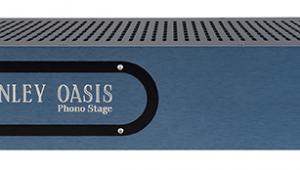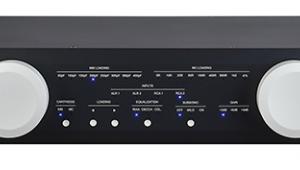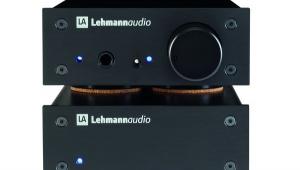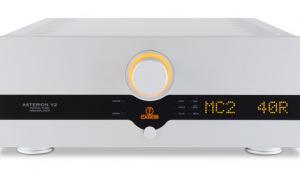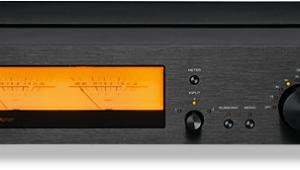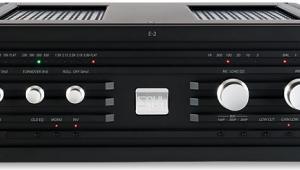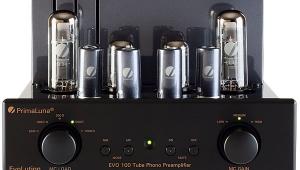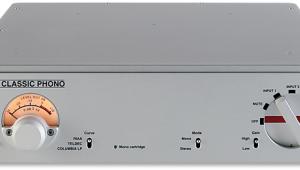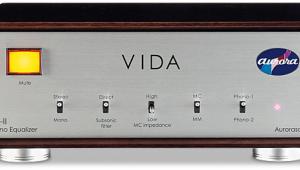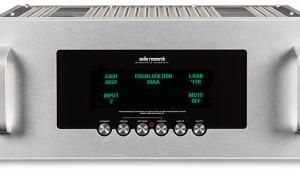Bel Canto e.One Phono phono stage

 Compact yet comprehensively-equipped, beautifully-made, with balanced outputs, MM/MC capability and a sane price, what’s not to like in Bel Canto’s e.One Phono?
Compact yet comprehensively-equipped, beautifully-made, with balanced outputs, MM/MC capability and a sane price, what’s not to like in Bel Canto’s e.One Phono?
Awash as we are with terrific phono stages, it takes a lot to stand out from the crowd. From sub-£50 units to £30,000-plus fantasy hardware, there are probably as many standalone phono stages on offer today as during the Original Vinyl Era. What Bel Canto offers with its e.One Phono, in its more cost-effective range, is a way to enjoy the adjustability demanded by perfectionists, at a sane price.
One might argue that £1250 ain’t peanuts, but I won’t go there: if you can’t afford this and you are new to vinyl, but you want decent cartridge matching, there are loads of units under £400, including the Arcam rPhono [HFN Jul ’17]. The e.One isn’t going to tackle a £2000+ model either, as it can only accept one deck rather than two or more. Also, its adjustments are more limited compared to, say, Perreaux’s VP3 phono stage [HFN Feb ’17]; it doesn’t have an external power supply like the Audio Alchemy PPA-1 [HFN Jan ’17]; etc, etc; but a plethora of settings is only a part of the recipe that makes for a fine phono section.
Easy Switch Access
Part of a range of units in the same mid-sized enclosure and offered in silver or black, the e.One phono stage complements a catalogue that also includes a DAC/preamp, a DAC-equipped integrated amp, mono and stereo power amps and a CD transport. This completes an e.One system that requires access to vinyl (though the integrated amp has a MM phono stage).
Let’s deal first with the real draw for cartridge aficionados, as opposed to those simply wanting a base-level, bare-bones phono stage to address a recent return to, or discovery of, vinyl in a home with a line-level-only system. As with countless others, Bel Canto has fitted two banks of DIP switches to adjust both gain and loading, accessible via the back and thus not first requiring the removal of the lid.
Both channels have their own mirrored sets of DIPs as this is effectively a dual-mono design. The jam-packed back panel thus contains RCA phono sockets for L/R inputs with a choice of balanced XLR or single-ended RCA outputs, while flanking the phono inputs are one set each of DIPs containing two switches for gain, with the default suitable for high-output moving-coils and all moving-magnet cartridges, and another per side with four switches for loading.
Here I came across my first pleasant surprise, as I fed this with a low-output Linn Arkiv MC on an LP12 with Ekos tonearm, before even checking as to what the gain or load settings were on the e.One Phono after it arrived from testing by editor PM. I may be making too much about the default settings of the gain switches, which were positioned for gain of 38dB: the Arkiv’s 0.4mV is low but still 0.1mV above Bel Canto’s recommendation for cartridges needing the higher gain setting of 60dB. Is that extra 0.1mV significant? All I know is that playback was fine without cranking the volume control any higher than I would consider ‘normal’, probably courtesy of that low, low noise floor identified by PM [see Lab Report].
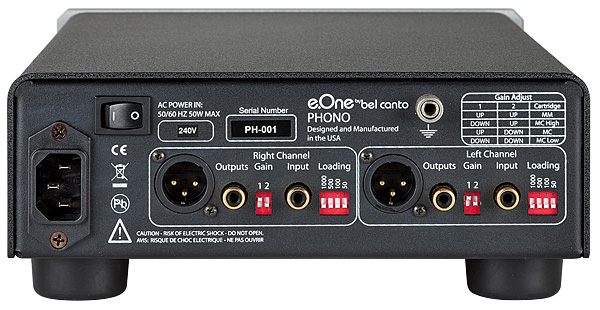
Getting The Best
Which brings us to a consideration also addressed by PM in his technical assessment. I soon learned that, beyond the obvious, say, extremes of 38dB versus 60dB gain, you really must adjust the settings by ear. It’s a bit of a pain as you can’t really A/B them, or set them on the fly – I got audible ‘clicks’ if I failed to use the ‘mute’ setting on my preamp. But setting them first by the numbers and later by fiddling around with them, I found that the settings one anticipated as ideal weren’t necessarily the best-sounding.
Also revealing as far as my screw-up goes is that I swear I connected the Linn Arkiv into a 47kohm load and it was still loud enough and ‘correct-sounding’ enough to mislead me into thinking I had lucked out with a favourable setting from the previous user. I only discovered my mistake by accident when I swapped turntables, which then prompted me to listen to the Arkiv again, but with settings more in keeping with its needs.
Which brings us to the other banks of DIPs. These offer, in combination, ten impedance settings, including one at 50ohm, which is the recommended load for the Arkiv. I immediately set it to that after discovering my screw-up, and, sure enough, I preferred it into 47kohm.
All of this brought back memories of another one-time craze in the world of audiophilia, when certain authorities were suggesting that all moving-coils sound best into 47kohm if there’s enough gain. That said, the other positions possible included 31, 45, 77, 83, 91, 100, 331, 495 and 980ohm. With all four in the ‘up’ position, the value is 47kohm.
As for the unit’s design, Bel Canto describes its circuit as an ‘optimised two-stage architecture’, with a low-noise 40dB input stage, a high-precision dual-mono RIAA network, a fully-regulated, multi-stage independent power supply, a custom-made discrete output stage with adjustable gain and an earthing-optimised PCB layout. Suffice it to say, the unit was quiet, with exceptional dynamics.
![]() Sheer Musicality
Sheer Musicality
What a beauty! It suffers quirks galore, but they cannot disguise the sheer musicality of this gem. And it was across the board, even serving time with an old PrimaLuna Prologue tube amp driving JBL 4312M II mini-monitors. If ‘fun’ is an acceptable term to use in a context some consider to be a life-or-death issue, then the e.Phono is akin to a real blast.
In addition to the Linn front-end, I also used my SME 30/2 MkIII turntable with Series V arm and London/Decca Gold cartridge, the SME 30/12 [HFN Mar ’09] with 12in Series V arm and an assortment of cartridges from TechDAS, Air-Tight and Lyra. And every single one of these sounded best with what I thought were ‘unlikely’ settings. So I am trying to do my best here, uncovering the inherent sound of the e.One Phono, rather than cite mismatches or ideal cases.

